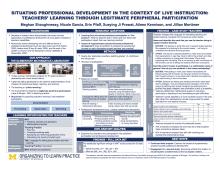Objectives & Perspectives: This project addresses a fundamental challenge for professional development––how to support teachers to improve their practice. Decades of research have demonstrated that many common approaches to professional development do not adequately support improvements in teachers’ capabilities (e.g., Cohen & Hill, 2001; Garet et. al, 2001; Tyler, 1971). In response, there has been increasing momentum around developing new and different forms of professional development. Needed are careful studies to understand the ways in which professional development can be designed to support the learning of practice and how key variations in the design impact teacher learning. Further, many studies of professional development do not examine whether changes in teaching practice are occurring, rather they assume teachers are learning or use non-practice or cognition-based measures.
This proposal is grounded in our work over the last decade to design professional development situated in a “live” case of elementary mathematics teaching. We seek to address the challenge of supporting the learning of practice by designing and studying an approach to professional development, situated in a common “live” case of elementary mathematics instruction. The approach uses this classroom as a “common text” for working on practice, where participants are not only watching and discussing, but are engaged in developing and refining practice. The research explores the impact of participation in these structured ways on teachers’ practice, as well as on their knowledge and dispositions. Our contribution is to rigorously study the impact of our professional model in situ to see whether the work transfers into classrooms.
Methods and Data Sources: The professional development is situated within a summer mathematics program for fifth graders. The class comprises primarily Black youth, along with a small number of Latinx and white children, mostly from low-income families. The teacher is an experienced teacher, comfortable with making her practice visible and open to others. Participants’ engagement approximates a form of “legitimate peripheral participation,” through structured conversations about the lesson plans, close observation, mathematical analysis of student tasks, and examination of records of teaching and learning practice.
We are studying elementary teachers (n = 24) who are participating in the professional development for five consecutive days (~25 hours). We are collecting and analyzing a set of pre- and post-measures including: a survey of mathematical knowledge for teaching (LMT, 2008), measures of teachers’ language in talking about students and teaching, and videos of classroom mathematics discussions which will be analyzed for the mathematical quality of instruction (Hill, Blunk, Charalambous, Lewis, Phelps, Sleep, & Ball, 2008) as well as a project-developed tool that focuses on mathematics discussions.
Results: Preliminary analysis of teachers’ pre-measures of classroom discussion reveal variability in the quality of discussions and show promise for revealing distinctions in teachers’ practice following the professional development. Our finding will also point to shifts in mathematical knowledge for teaching, and ways of talking about children and their learning, and teaching practice.
Significance: The study contributes to a growing body of research about how to support teachers to improve their teaching practice.
